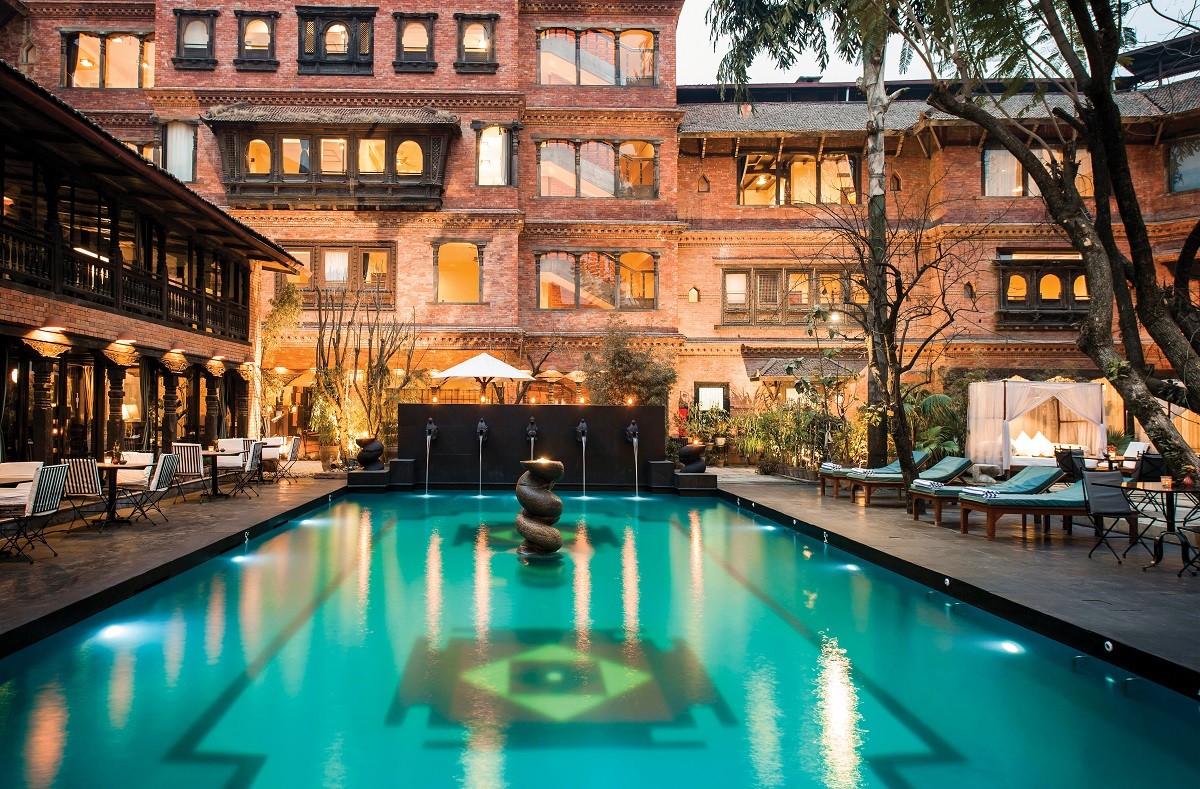As a consequence, the Nepalese government cut off the Mustang region from the rest of the world: Merchants and caravans were banned from the area, thereby keeping it untainted by commercial transformation for decades.
In the early 1990s, Nepal finally bowed to international pressure to open up this part of the country to trade. And only recently—in August 2023—did world-class luxury hotels like Shinta Mani Mustang open, allowing visitors to truly experience this unspoiled part of the world in style. Even so, there is far more to the region than first meets the eye. To journey to this once forbidden region means to truly step back in time.
Location, Location, Location
Traveling to Mustang begins with a flight into Kathmandu. From there, a scenic helicopter ride over lush green paddy fields will take you to Pokhara, and then drive or take a helicopter to Mustang. Booking a premium, exclusive tour with bespoke travel company Red Savannah offers an experience where all details are taken care of in the most comfortable way possible—from booking helicopters to chauffeured four-wheel vehicles and knowledgeable guides who are experts in the geology and culture of the area.
The journey from Pokhara to Mustang is ever-changing and particularly scenic: The route traces river valleys past glimpses of tiny villages and lush vegetation, through intricately terraced hills, where local farmers cultivate the fertile slopes. Rachel Cooper, a regional manager for Red Savannah tours, poetically directs the way along “a road that ascends and transforms into dense forests, before the majestic backdrop of the Annapurna and Dhaulagiri mountain ranges.” The passage through the Kali Gandaki Gorge, one of the planet’s deepest, adds a dramatic dimension with its towering cliffs and swiftly flowing river.
Its name derived from a Tibetan word meaning “plain of aspiration,” Mustang is the second least-populated district in Nepal. Once a part of the Lo Manthang Kingdom, it became a district of Nepal after the dissolution of the Shah dynasty in 2008. The remote location alone has drawn travelers: Having been inaccessible for so long, it has remained an untarnished and rare gem. Outdoorsy types with a taste for luxurious accommodations can now indulge themselves at Dwarika’s Hotel in Kathmandu before continuing on to Shinta Mani Mustang—both feature superb suites, spacious courtyards, spas, and grandeur that takes you back in time while being nestled in raw, breathtaking landscapes.
Part of Gandaki Province in northern Nepal, Mustang district abuts the Himalayas to the south and the Tibetan Plateau to the north. There is a rugged, majestic beauty about it, encircled by some of the world’s tallest peaks, including Annapurna and Dhaulagiri. To fuel your expeditions, the cuisine offered in the area is ideal for the health-conscious: Dishes from the Thakali and Newari cultural communities focus on fresh ingredients, and feature lentils and a variety of vegetables and meats.
“This area really allows you to get under the skin of the destination,” says George Morgan-Greenville, Red Savannah’s founder and owner. “It’s also truly off the grid: Once people visit, they can find it alarming but then they get used to not having cell phone service, and they just love it.”
Luxe Lodging
Staying in a landscape that looks a lot like wilderness doesn’t mean sacrificing any creature comforts. Shinta Mani Mustang, a glorious resort designed by Bill Bensley and owned and operated by HMD Asia, opened its doors in August 2023. The brand’s first international property outside Cambodia could not be more breathtaking, located at a soaring elevation of 9,186 feet. Just 500 feet below the resort flows the Kali Gandaki River.
The all-inclusive property—known for its sustainable design solutions—offers 29 rooms, each of them spacious: more than 2,400 square feet filled with exquisite antiques from Gandaki Province and fitted in the style of a traditional local home, with an open-plan bedroom, living room and bathroom.
Interiors carry on the narrative from the outside, reflecting the warm tones of the surrounding landscape. Throughout the hotel you’ll enjoy the works of late artist Robert Powell, known for his detailed paintings of Lo Manthang.
As you open your curtains in the morning, the rising sun fills your room and gently rouses you to greet a day of discovery in this mountain kingdom. (Or you may not want to close your curtains at night: The views are so magical that if you wake up for a glass of water, you’ll marvel at the nocturnal landscape surrounding you.)
Four-wheel drive Land Rovers transport guests to local attractions and trekking spots—and because the resort has a unique adventure every day for up to two weeks, no two days will be alike. One day could take you to the beautifully preserved Marpha Village, and another to a local hike. Created by expert guide Jason Friedman over the course of three years, the mini trips are led by Bensley adventure guides and are completely tailored to individual families and personality types, covering cuisine, culture, physical activity and geography.
Food for Thought
There’s no lack of great culinary options: The 60-seat Nilgiri Restaurant, named after the grand mountain that it looks upon, boasts a modern menu using local delicacies. Every night has a theme that reflects various parts of the country in recipes that are both ancient and modern. For example, the Foraging Dinner offers guests an herb salad harvested in the nearby forest and just-picked local mushrooms in risotto. Freshly caught pan-seared trout is sourced from a river mere minutes away from the property. Another highlight is the Himalaya Dinner, a nine-course degustation menu featuring traditional momos (local dumplings) that are truffle-infused, filled with Himalayan yak meat and spiced with tomato achaar (South Asian pickle).





